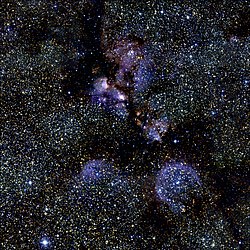NGC 6334
| NGC 6334 | |
 | |
| Observationsdata | |
|---|---|
| Typ | Emissionsnebulosa |
| Stjärnbild | Skorpionen |
| Rektascension | 17t 19m 58s |
| Deklination | -35° 57′ 47″ |
| Avstånd | 5500 +/-970 ljusår |
| Skenbar storlek | 35 × 20 |
| Noterbart | På engelska har den de beskrivande namnen Cat's Paw Nebula och Bear Claw Nebula |
| Upptäckt | |
| Upptäcktsår | 7 juni 1837 |
| Upptäckare | John Herschel |
| Andra beteckningar | |
| GC 4288, h 3678, ESO 392-EN009, Lund 745, Sharpless 8, RCW 127, Gum 64, CTB 39, GRS G351.40 +00.70, Kes 49, LMH 1, MHR 64, Min 1-86, MSH 17-3-04, SNR G351,1+00.7[1][2] | |
| Se även: Nebulosor, Lista över nebulosor | |
NGC 6334 är en emissionsnebulosa i stjärnbilden Skorpionen.[3] Den upptäcktes av astronomen John Herschel den 7 juni 1837 från Godahoppsudden i Sydafrika. Han katalogiserade den först som h 3678 i sin stjärnkatalog från 1847. Den blev senare GC 4288 i hans katalog 1864 (GC = General Catalogue).
Den har sedan dess fått många fler beteckningar och namn, som kan ses i faktarutan till höger.[4]
Fotografi taget med MPG/ESO-teleskopet vid La Silla-observatoriet i Chile.
Europeiska sydobservatoriets VISTA-teleskop - ett infraröd-fotografi av NGC 6334.
Referenser
- ^ ”NGC 6334 -- SuperNova Remnant”. SIMBAD Astronomical Database. http://simbad.u-strasbg.fr/simbad/sim-basic?Ident=NGC+6334. Läst 9 augusti 2013.
- ^ ”Statistical study of OB stars in NGC 6334 and NGC 6357”. SAO/NASA ADS Astronomy Abstract Service. http://adsabs.harvard.edu/abs/2012A%26A...538A.142R. Läst 9 augusti 2013.
- ^ ”Astronomy Picture of the Day”. NASA. http://apod.nasa.gov/apod/ap030717.html. Läst 9 augusti 2013.
- ^ ”NGC 6334 - The Cat's Paw Nebula”. SEDS Database. http://spider.seds.org/spider/Misc/n6334.html. Läst 9 augusti 2013.
Externa länkar
Media som används på denna webbplats
Författare/Upphovsman: ESO, Licens: CC BY 4.0
The Cat's Paw Nebula (NGC 6334) is a vast region of star formation. This portrait of NGC 6334 was created from images taken with the Wide Field Imager instrument at the 2.2-metre MPG/ESO telescope at the La Silla Observatory in Chile, combining images taken through blue, green and red filters, as well as a special filter designed to let through the light of glowing hydrogen. NGC 6334 lies about 5500 light-years from Earth in the constellation of Scorpius. The whole gas cloud is about 50 light-years across.
NGC 6334 is one of the most active nurseries of massive stars in our galaxy and has been extensively studied by astronomers. The nebula conceals freshly minted brilliant blue stars — each nearly ten times the mass of our Sun and born in the last few million years. The region is also home to many baby stars that are buried deep in the dust, making them difficult to study. In total, the Cat’s Paw Nebula could contain several tens of thousands of stars.
The nebula appears red because its blue and green light are scattered and absorbed more efficiently by material between the nebula and Earth. The red light comes predominantly from hydrogen gas glowing under the intense glare of hot young stars.Författare/Upphovsman: ESO/J. Emerson/VISTA, Licens: CC BY 4.0
Infrared view of the Cat’s Paw Nebula (NGC 6334) taken by VISTA. NGC 6334 is a vast region of star formation about 5500 light-years from Earth in the constellation of Scorpius. The whole gas cloud is about 50 light-years across. NGC 6334 is one of the most active nurseries of young massive stars in our galaxy, some nearly ten times the mass of our Sun and most born in the last few million years. The images were taken through Y, J and Ks filters (shown as blue, green and red respectively) and the exposure time was five minutes per filter. The field of view is about one degree across.
NGC 6334 "Cat's Paw Nebula", Scorpius Constellation




